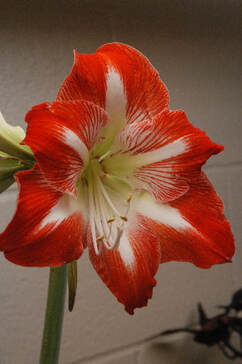
Amaryllis bulbs can be huge – approaching the size of a grapefruit. The larger the bulb, the larger the flowers and the more expensive the bulb. Regardless of size, amaryllis likes tight quarters. Place in a pot only 1 to 2 inches larger in diameter than the bulb. About half of the bulb should remain exposed. Hold the bulb so the roots hang down into the pot, and add potting mix. Firm the mix around the roots carefully so that they are not snapped off. Water thoroughly and place the plant in a warm, sunny location. Amaryllis likes day temperatures in the 70s and night temperatures in the 60s. The flower bud may start to appear right away or the plant may remain dormant for a period of time, but eventually all mature bulbs do bloom. Move the plant to a cooler location and out of direct sunlight when the flower buds begin to show color so the flowers last longer. Amaryllis can remain in bloom for about a month.
Flowers should be cut off after blooming to keep the plant from expending energy to form seeds. Place the plant back in a sunny location until it is warm enough to be placed outside. Sink the pot in the soil in an area that has dappled shade. The plant can be gradually moved to sunnier locations until it receives full sun for a half day. Continue to fertilize with a balanced houseplant fertilizer as you would a normal houseplant. Bring the pot in before first frost and place in a dark location. Withhold all water so the leaves have a chance to dry completely. Leaves can then be cut off close to the top of the bulb. Amaryllis can often be left in the same pot for several years but will eventually need repotting. Again, choose a pot that is only 1 to 2 inches larger in diameter than the bulb and repeat the process described above. Offsets are normally produced by amaryllis and can be given their own pots if desired. These small bulbs have a concave side when removed but develop a round shape when given their own space. They grow quickly and can be mature enough to flower in a couple of years. (Ward Upham)
 RSS Feed
RSS Feed
